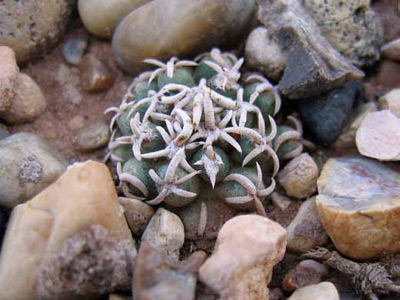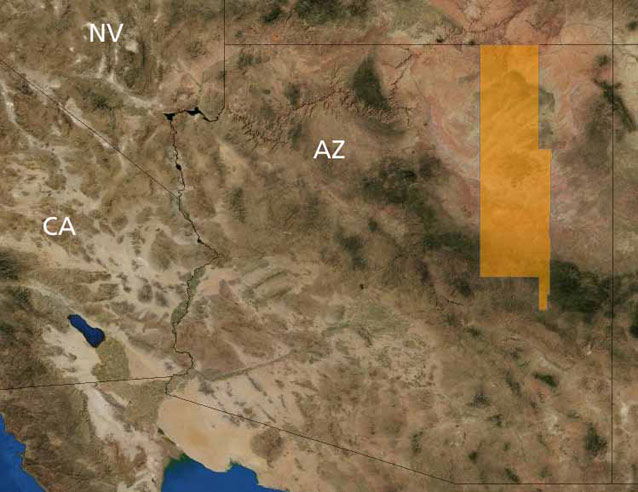Habitat and Ecology

Jeff Servoss / USFWS
Peebles Navajo cactus (Pediocactus peeblesianus var. peeblesianus) occurs in two core populations near Holbrook and Joseph City, Arizona. It only grows on the gravelly soils of old channels of the Little Colorado River. These soils are well-drained and occur on the gentle slopes of low hills. The vegetation on these soils is open and sparse. Peebles Navajo cactus grows at elevations between 1555 and 1720 m (5100 and 5650 ft). At the time of its listing, the cactus only occurred on 80-85% of its potential habitat, suggesting that it may have even more specific habitat requirements than are currently known.
Description
Peebles Navajo cactus is a very small succulent with two to four round, unbranched stems. It grows from 2.5-6.5 cm tall and 1.5-5.5 cm wide, but often only the tops of the stems protrude above the ground. Each stem has spongy, white spines that form a twisted cross. Four, but sometimes three or five, of these spines cluster together. In late April, yellow-green flowers bloom. The flowers are often larger than the cactus stem. The small fruits become reddish-brown at maturity and contain dark brown to black seeds.

USFWS
Conservation Status and Threats
The U.S. Fish and Wildlife Service has listed Peebles Navajo cactus as an endangered species since November 28, 1979. Arizona lists it as critically imperiled.
Over twenty years of monitoring, the populations of Peebles Navajo cactus have shrunk. Monitoring has also shown that the populations tend to increase during wet years and decrease during dry ones. During dry years, the plants die from water stress and may be eaten by rabbits and other rodents, who only eat cacti when more palatable plants are not available. Peebles Navajo cactus is also threatened by human activity, including livestock grazing and off-road vehicle use. In addition, gravel quarrying has destroyed possibly as much as one-fourth of the potential habitat for the cactus.
Related species
The closest relative of Peebles Navajo cactus is Fickeisen plains cactus (Pediocactus peeblesianus var. fickeiseniae). Unlike Fickeisen plains cactus, Peebles Navajo cactus lacks a central spine, has fewer spines in the spine clusters, and has stems that are always unbranched.
References
Arizona Game and Fish Department. 2009. Plant abstract for Pediocactus peeblesianus var. peeblesianus. Heritage Data Management System, Arizona Game and Fish Department, Phoenix, AZ. Available at http://www.azgfd.gov/w_c/edits/documents/ Pedipepe.d_001.pdf (accessed 17 June 2010).
Heil, D. K., and J. M. Porter. 1993. Pediocactus peeblesianus. Pages 164, 208, 212, 213, and 216 in Flora of North America. Volume 4. NewYork, NY, and Oxford, UK.
NatureServe. 2009. Pediocactus peeblesianus var. peeblesianus. NatureServe explorer: An online encyclopedia of life. Version 7.1. NatureServe, Arlington, VA. Available at http://www.natureserve. org/explorer/ (accessed 17 June 2010).
U.S. Fish and Wildlife Service. 1984. Peebles Navajo cactus (Pediocactus peeblesianus var. peeblesianus) recovery plan. U.S. Fish and Wildlife Service, Albuquerque, NM. Available at http://www.fws.gov/ecos/ ajax/docs/recovery_plan/840330b.pdf (accessed 17 June 2010).
U.S. Fish and Wildlife Service. 2008. Peebles Navajo cactus (Pediocactus peeblesianus var. peeblesianus). 5-year review: summary and evaluation. Arizona Ecological Services Office, U.S. Fish and Wildlife Service, Phoenix, AZ.
Prepared by Kelly Reeves, Southern Colorado Plateau Network Inventory and Monitoring Program, 2010.
Last updated: July 29, 2015
